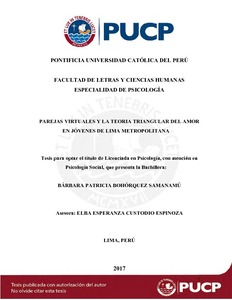| dc.contributor.advisor | Custodio Espinoza, Elba Esperanza | es_ES |
| dc.contributor.author | Bohórquez Samanamú, Bárbara Patricia | es_ES |
| dc.date.accessioned | 2017-09-05T15:42:33Z | es_ES |
| dc.date.available | 2017-09-05T15:42:33Z | es_ES |
| dc.date.created | 2017 | es_ES |
| dc.date.issued | 2017-09-05 | es_ES |
| dc.identifier.uri | http://hdl.handle.net/20.500.12404/9293 | |
| dc.description.abstract | En la presente investigación se exploran las expectativas de la relación entre las parejas
virtuales y los componentes de la Teoría Triangular del Amor: Intimidad, Pasión y
Compromiso, en una muestra de 253 jóvenes entre 18 y 30 años de edad de Lima
Metropolitana. El instrumento que se utilizó fue la Escala Triangular del Amor de
Sternberg (1986). Se compararon las medianas de algunas variables sociodemográficas con
los componentes de la prueba. Por un lado, en las comparaciones según sexo se encontraron
diferencias a favor de las mujeres en Pasión y Compromiso. Por otro lado, en las
comparaciones según la edad de los participantes, el grupo que obtuvo mayor puntaje fue el
de 23-26 años, con diferencias significativas en las tres dimensiones. Y, finalmente, ya que
se tomó en cuenta si las personas estaban en una relación de pareja, se comparó el tiempo
de relación con las escalas. El grupo de 1 año de relación fue el que obtuvo los puntajes
más altos en Pasión e Intimidad, y el de 2 años de relación en Compromiso. | es_ES |
| dc.description.abstract | The present research explores the expectations about the relationship between virtual
couples and the components of the Triangular Theory of Love: Intimacy, Passion and
Commitment, in a sample of 253 young people between 18 and 30 years old from
Metropolitan Lima. The instrument used was Sternberg's Triangular Love Scale (1986).
The medians of some sociodemographic variables were compared with the components of
the test. On the one hand, in the comparisons according to sex, differences were found in
favor of women in Passion and Commitment. On the other hand, in the comparisons
according to the age of the participants, the group that obtained the highest score was 23-26
years, with significant differences in the three dimensions. And finally, since it was taken
into account if the people were in a relationship, we compared the relationship time with
the scales. The 1-year relationship group was the one that obtained the highest scores in
Passion and Intimacy, and the 2-year relationship in Commitment. | es_ES |
| dc.language.iso | spa | es_ES |
| dc.publisher | Pontificia Universidad Católica del Perú | es_ES |
| dc.rights | Atribución-NoComercial-SinDerivadas 2.5 Perú | * |
| dc.rights | info:eu-repo/semantics/openAccess | es_ES |
| dc.rights.uri | http://creativecommons.org/licenses/by-nc-nd/2.5/pe/ | * |
| dc.subject | Amor | es_ES |
| dc.subject | Pasión | es_ES |
| dc.subject | Jóvenes--Perú--Lima--Investigaciones | es_ES |
| dc.subject | Relaciones de pareja | es_ES |
| dc.title | Parejas virtuales y la teoría triangular del amor en jóvenes de Lima Metropolitana | es_ES |
| dc.type | info:eu-repo/semantics/bachelorThesis | es_ES |
| thesis.degree.name | Licenciado en Psicología Social | es_ES |
| thesis.degree.level | Título Profesional | es_ES |
| thesis.degree.grantor | Pontificia Universidad Católica del Perú. Facultad de Letras y Ciencias Humanas | es_ES |
| thesis.degree.discipline | Psicología Social | es_ES |
| renati.discipline | 313066 | es_ES |
| renati.level | https://purl.org/pe-repo/renati/level#tituloProfesional | es_ES |
| renati.type | http://purl.org/pe-repo/renati/type#tesis | es_ES |
| dc.publisher.country | PE | es_ES |
| dc.subject.ocde | http://purl.org/pe-repo/ocde/ford#5.01.00 | es_ES |






